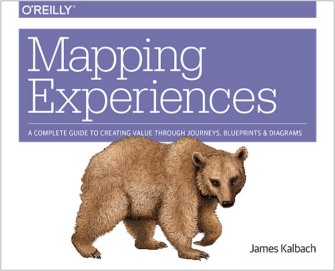Process: Journey Mapping
UXmatters has published 8 articles on the topic Journey Mapping.
Top 3 Trending Articles on Journey Mapping
-
Mapping Experiences
September 26, 2016No CommentsThis is a sample chapter from the book Mapping Experiences: A Complete Guide to Creating Value Through Journeys, Blueprints, & Diagrams, by Jim Kalbach, which O’Reilly Media published in May 2016. UXmatters is publishing this chapter with O’Reilly’s permission. Copyright © 2016 O’Reilly Media. All rights reserved.
Chapter 4: Initiate: Starting a Mapping Project
 One of the most common questions I get in my workshops on mapping is, “How do I begin?” Aspiring mapmakers may see the immediate value in these techniques, yet they have barriers getting started.
One of the most common questions I get in my workshops on mapping is, “How do I begin?” Aspiring mapmakers may see the immediate value in these techniques, yet they have barriers getting started.Getting stakeholder buy-in is a common challenge. I’ve been fortunate to have had opportunities to create diagrams of all kinds and have found that stakeholders see the value in mapping only after the process is complete. As a result, initiating an effort requires convincing them up front. Read More
-
Envisioning Experience Outcomes
April 20, 2015When your organization’s goal is to differentiate on the experience, you must start every product-development project by defining the experience that you want people to have with your product or service. Companies that differentiate on the experience do not begin by defining feature sets. They first define a vision for the experience outcome that they intend to deliver to their users and customers. Only once your team fully understands the experience outcomes that you want users to have can you make good decisions about what features and technologies would optimally support that vision.
This is the fourth column in our series about what companies must do if they want to stop producing average user experiences and instead design great experiences. As we have already stated in our previous columns, great UX teams focus on differentiating their companies through design. If that’s your goal, you need to work for a company that shares your aspirations. Read More
-
The Role of Data in Designing User Journeys
June 3, 2024Data has become the cornerstone of the creation of exceptional user journeys. By collecting and analyzing data from various sources, software as a service (SaaS) companies can gain a deep understanding of their customers’ behaviors, preferences, and expectations. These insights are crucial to shaping the customer experience at every stage of the user journey.
As Figure 1 shows, the customer journey for SaaS companies typically consists of four main stages: acquisition, conversion, retention, and referral. I’ll provide a brief overview of these stages before I delve more deeply into each stage. Read More
All Articles on Journey Mapping
- The Role of Data in Designing User Journeys
- Using Analog UX Strategy Tools
- Book Review: The User’s Journey: Storymapping Products That People Love
- Book Review: User Story Mapping
- Mapping Experiences
- The Data-Informed Customer Journey
- Journey Maps: Not the End of the Story
- Envisioning Experience Outcomes
New on UXmatters
- Linking Customer Experience to Business Results for Sustainable Growth
- Using AI to Design Better Mobile-App User Experiences
- Leveraging the Psychology of Color in UX Design for Health and Wellness Apps
- Elevating the User Experience and Fostering Loyalty: Accessible Design for Travel-Booking User Interfaces
- Using Data Analytics to Optimize the In-Store and Online Retail Experience